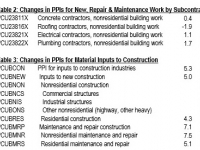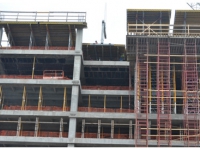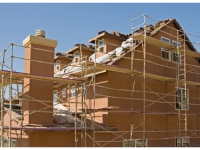MHC, AIA, NABE surveys imply improving construction market; retailers think smallEditor’s note: Construction Citizen is proud to partner with AGC America to bring you AGC Chief Economist Ken Simonson's Data DIGest. Check back each week to get Ken's expert analysis of what's happening in our industry.“New construction starts in June advanced 6%” at a seasonally adjusted annual rate to the highest level so far in 2014, McGraw Hill Construction (MHC) reported last Tuesday. “Nonresidential building strengthened [+12%] after pulling back in May, with the lift coming from the start of several large manufacturing plant projects. Modest gains in June were also reported for housing [+3%] and nonbuilding construction (public works and electric utilities) [+2%]. During the first six months of 2014, total construction starts on an unadjusted basis were…up 1% from the same period a year ago….During the first two months of 2014 [activity was sluggish], but then the pace of construction starts began to pick up…‘The first half of 2014 revealed a mixed performance by project type,’ stated Robert A. Murray, chief economist for [MHC].
Most states add jobs year-over-year but not since May; most PPIs remain mild in JuneEditor’s note: Construction Citizen is proud to partner with AGC America to bring you AGC Chief Economist Ken Simonson's Data DIGest. Check back each week to get Ken's expert analysis of what's happening in our industry.Seasonally adjusted construction employment increased in 38 states and the District of Columbia from June 2013 to June 2014 and decreased in 12 states, an AGC analysis of Bureau of Labor Statistics (BLS) data released Friday showed. The largest percentage gains were in Florida (11%, 41,700 jobs), Nevada (10%, 5,900) and Utah (9.3%, 6,800). Florida added the most jobs, followed by California (29,800, 4.7%) and Texas (19,100, 3.1%). The steepest 12-month percentage losses occurred in New Jersey (-8.1%, -11,200) and Alaska (-5.5%, -900). New Jersey lost the most construction jobs, followed by Arizona (-4,500, -3.6%). For the month, 21 states and D.C. added construction jobs, 27 states lost jobs and Arizona and New Mexico had no change.
July 21, 2014
Starts jump in June, Reed says; several reports point to growth in diverse segmentsin MayEditor’s note: Construction Citizen is proud to partner with AGC America to bring you AGC Chief Economist Ken Simonson's Data DIGest. Check back each week to get Ken's expert analysis of what's happening in our industry.The value of nonresidential construction starts in June jumped 14% compared with June 2013, Reed Construction Data reported Friday, based on data it collected. Cumulative starts for the first half of 2014 exceeded January-June 2013 starts by 2.4%. Nonresidential building starts slipped 3.1% year-to-date, with a 14.5% drop in commercial starts offsetting gains of 5.9% for institutional buildings and 13.5% for industrial (manufacturing). Heavy engineering starts rose13% year-to-date.
July 14, 2014
June employment, May spending rise for construction; most metros add jobs in MayEditor’s note: Construction Citizen is proud to partner with AGC America to bring you AGC Chief Economist Ken Simonson's Data DIGest. Check back each week to get Ken's expert analysis of what's happening in our industry.Nonfarm payroll employment rose by 288,000, seasonally adjusted, in June and 2,495,000 (1.8%) over 12 months, the Bureau of Labor Statistics (BLS) reported last Thursday. Construction employment rose by 6,000 for the month and 186,000 (3.2%) over the year to 6,015,000, the highest total since June 2009. Residential construction employment (residential building and specialty trade contractors) climbed by 6,600 for the month and 106,300 (4.9%) for the year. Nonresidential employment (building, specialty trades, and heavy and civil engineering construction) was flat in May and up 80,000 (2.2%) year-over-year. All five residential and nonresidential segments added workers over 12 months. Aggregate hours worked in construction increased 3.2% over 12 months, while average hourly earnings rose 2.3%.
July 07, 2014
40 states, DC add jobs in May; surveys show varied trends for housing, nonres activityEditor’s note: Construction Citizen is proud to partner with AGC America to bring you AGC Chief Economist Ken Simonson's Data DIGest. Check back each week to get Ken's expert analysis of what's happening in our industry.Seasonally adjusted construction employment increased in 40 states and the District of Columbia from May 2013 to May 2014 and decreased in 10 states, an AGC analysis of Bureau of Labor Statistics (BLS) data released on June 20 showed. The largest percentage gains were in Nevada (13%, 7,000 jobs), Florida (9.8%, 35,300) and Minnesota (9.7%, 9,700). California added the most jobs (37,300, 5.9%), followed by Florida and Texas (26,500, 4.3%). The steepest 12-month percentage losses occurred in West Virginia (-6.3%, -2,200), New Jersey (-6.2%, -8,500) and Montana (-5.7%, -1,400). New Jersey lost the most construction jobs, followed by Arizona (-4,100, -3.3%). For the month, 30 states and D.C. added construction jobs, 19 states lost jobs and Alaska had no change.
June 30, 2014
PPIs remain calm overall but rise for finished buildings; oil-by-rail niche mushroomsEditor’s note: Construction Citizen is proud to partner with AGC America to bring you AGC Chief Economist Ken Simonson's Data DIGest. Check back each week to get Ken's expert analysis of what's happening in our industry.The producer price index (PPI) for final demand slid 0.3%, not seasonally adjusted (-0.2%, seasonally adjusted), in May and rose 2.0% over 12 months, the Bureau of Labor Statistics reported Friday. AGC posted an explanation and tables focusing on construction prices and costs. Final demand includes goods, services and five types of nonresidential buildings that BLS says make up 34% of total construction. There are no indexes yet for other building types, residential or nonbuilding construction. The PPI for final demand construction, not seasonally adjusted, rose 0.1% in May and 3.2% over 12 months. The overall PPI for new nonresidential building construction—a measure of the price contractors say they would charge to build a fixed set of five categories of buildings—increased 0.1% for the month and 3.3% since May 2013.
June 16, 2014
Construction payrolls and spending edge higher; Beige Book points to further growthEditor’s note: Construction Citizen is proud to partner with AGC America to bring you AGC Chief Economist Ken Simonson's Data DIGest. Check back each week to get Ken's expert analysis of what's happening in our industry.Nonfarm payroll employment rose by 217,000, seasonally adjusted, in May and 2,379,000 (1.7%) over 12 months, the Bureau of Labor Statistics (BLS) reported Friday. Construction employment rose by 6,000 for the month and 189,000 (3.3%) over the year to 6,004,000, the highest total since June 2009. Residential construction employment (residential building and specialty trade contractors) climbed by 3,300 for the month and 105,600 (4.9%) for the year. Nonresidential employment (building, specialty trades, and heavy and civil engineering construction) rose by 2,700 from April and 82,000 (2.2%) year-over-year. All five residential and nonresidential segments added workers over 12 months.
June 09, 2014
More metros add jobs in April; construction costs stay mild in first quarter, Means saysEditor’s note: Construction Citizen is proud to partner with AGC America to bring you AGC Chief Economist Ken Simonson's Data DIGest. Check back each week to get Ken's expert analysis of what's happening in our industry.From April 2013 to April 2014 construction employment increased in 220 out of 339 metropolitan areas for which the Bureau of Labor Statistics reports construction data, declined in 70 and was unchanged in 49, according to an analysis that AGC released last Tuesday. (The agency combines mining and logging with construction in most metros to avoid disclosing data for industries with few firms. Because metro data is not seasonally adjusted, comparisons with months other than April are not meaningful.) Three divisions of larger metros added the most jobs over the year: Los Angeles-Long Beach-Glendale (11,100 construction jobs, 10%), followed by Dallas-Plano-Irving (9,500 combined jobs, 9%) and Santa Ana-Anaheim-Irvine, Calif. (8,500 construction jobs, 11%).
June 02, 2014
South, West lead in population growth as cities outpace suburbs; starts rise, MHC saysEditor’s note: Construction Citizen is proud to partner with AGC America to bring you AGC Chief Economist Ken Simonson's Data DIGest. Check back each week to get Ken's expert analysis of what's happening in our industry.“The South and West dominated the list of fastest-growing municipalities between 2012 and 2013, claiming all of the top 15, seven of which were in Texas,” the Census Bureau reported last Thursday. “San Marcos, Cedar Park and Georgetown—each near Austin—ranked among the 10 fastest-growing cities with populations of 50,000 or more during the year ending July 1, 2013. San Marcos was number one in percent growth [8.0%] for the second consecutive year, with Austin itself gaining more people (nearly 21,000) than any [other] city with fewer than 1 million residents.” Population growth is a major driver of residential construction and contributes to demand for many other types, particularly if growth occurs in new areas or outer parts of metro areas. The Wall Street Journal reported last Thursday, “just 18 of America’s 51 metropolitan areas with more than 1 million people had cities growing faster than their suburbs last year, down from 25 in 2012, according to an analysis of census data by William H. Frey,
May 27, 2014
39 states, DC add jobs in last 12 months; multifamily starts, permits outrun single-family Editor’s note: Construction Citizen is proud to partner with AGC America to bring you AGC Chief Economist Ken Simonson's Data DIGest. Check back each week to get Ken's expert analysis of what's happening in our industry.Seasonally adjusted construction employment increased in 39 states and the District of Columbia from April 2013 to April 2014, decreased in 10 states, and remained level in Wyoming, an AGC analysis of Bureau of Labor Statistics (BLS) data released Friday showed. The largest percentage gains were in Florida (12%, 43,300 jobs), North Dakota (11%, 3,400) and Nevada (9.4%, 5,400). Florida also led in number of jobs added, followed by California (39,000, 6.2%) and Texas (23,900, 3.9%). New Jersey lost the most construction jobs (-9,300, -6.8%), followed by New Mexico (-2,000, -4.8%), West Virginia (-1,300, -3.7%) and Alabama (-2.2%, -1,800).
May 19, 2014






















